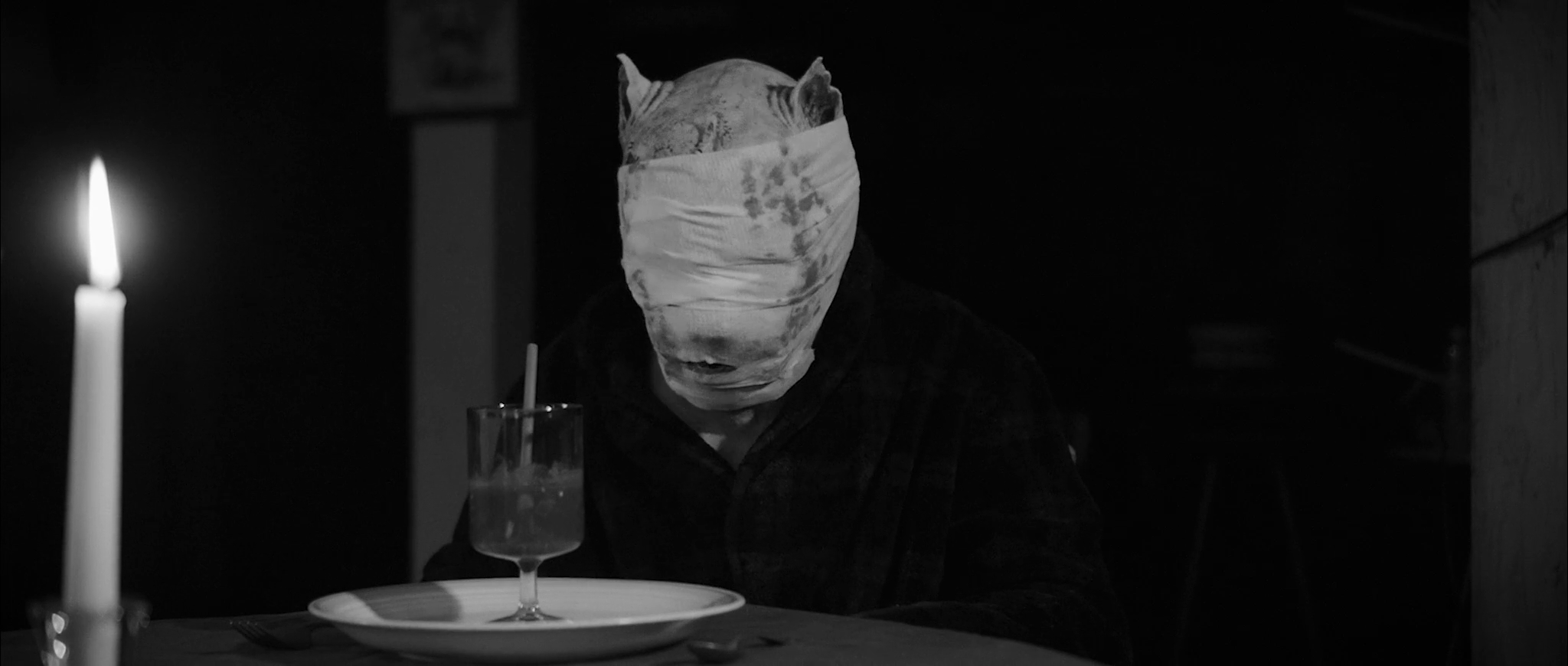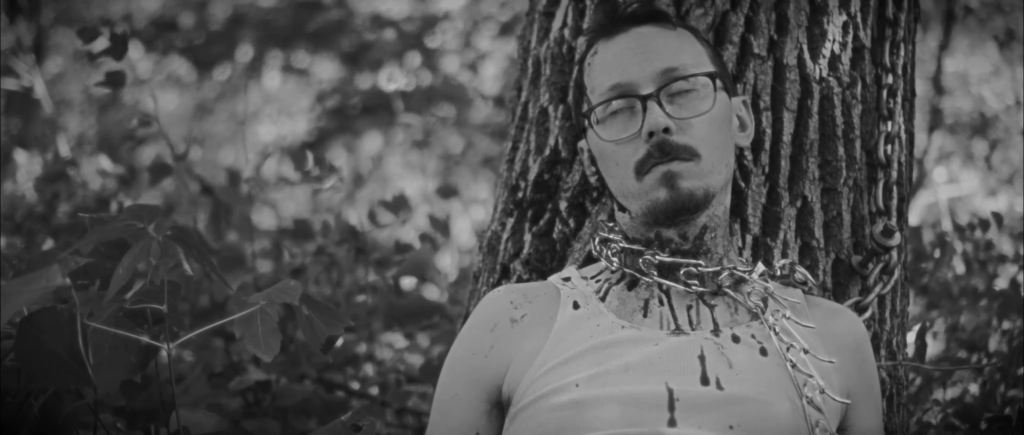
“You become what you believe” seems to be an enthusiastic phrase until you watch Josh Stifter’s black comedy horror Greywood’s Plot. Born out of a low-budget production and undying devotion of four friends, Greywood’s Plot is an admirable endeavor that proves imagination is man’s only limit. Screening at U.K’s biggest horror film festival, Frightfest 2021, Stifter’s offbeat horror presents an independent attitude and ingenuity that makes it a necessary watch at the festival. Apparently, the whole process and outcome look like Sifter’s own aptitude test, on how he could actualize his vision regardless of the dearth of legroom. Fortunately, his and his team’s valiant efforts made this ambitious film a reality and is set to capture the heart of horror devotees and casual onlookers alike.
The film follows the story of two friends, who host a cryptozoology website, and subsequently enter the woods to verify an anonymous tape recording of the infamous Chupacabra. It is not a full-fledged found footage film, but rather, they utilize the potential eeriness of found footage tapes in real life and make it one of the horror tropes stamped in the movie. From the very beginning, Dominic (played by Josh Stifter) plans to commemorate his life by arranging a found footage situation where his mother is to discover his life narrated in a single CD after he dies. He also stumbles onto an unidentified VHS tape in a found footage manner, received from an anonymous sender. And of course, the ending played around the dismay engendered by uncovering a sickening, unattributed videotape. Until the very end, the film employed its take on the found footage genre and succeeded in doing so.

The experimentation on the found footage subgenre is not the only aspect that deserves appreciation, however. Black comedy is one of the significant feats. The characters are the other. Part of the reason why Greywood’s Plot never runs out of steam is its scathing dialogue that perfectly reflects a nihilistic nature. The scene where Dominic eats Chinese food with his mother on the sofa while watching true crime documentaries is probably the height of the black comedy. The fact that they can leisurely savor their food while gazing at horrendous crimes is subtlety morbid. Furthermore, their conversation, where the two verbally spar, comes off naturally engaging not only because they are well-performed, but the dialogue itself is eerily funny. The black comedy also develops from the visuals themselves. From the title card to the driving homage to their envisioned dreams, we are thoroughly entertained by its funky graphics that subvert or poke fun at its implicit hints of violence.
Speaking of characters, Dominic is the most interesting bit of the film, thanks to the performance of the director himself. He reminds us of the archetypical Woody Allen figure in his starred films, which is a neurotic schlub finding meaning behind his existential crisis. Dominic’s character never left us hanging as his enthusiasm and drama pulls us closer to the screen. As the tone of the film, Dominic is inherently nihilistic. We relate to him as he questions his motivations and attempts to cross the borders of life and death. But, he clings to Cryptozoology as his last skidmark of life, an antithesis to his suicidal nature. We sympathize with his doubtful journey because watching him desperately prove the truth of folklore is reminiscent of the risks we are willing to take every day to get a glimpse of purpose that will help us push through impediments of life.
Contrasting this desirous character is Miles (played by Keith Radichel) who, unlike his best friend, wants to put their long-overdue cryptozoology journey behind them. Miles’ character is also relatable as his doubts are pretty understandable, and we get to feel both sides of the coin as Miles exhibits a sense of reason that Dominic barely has. However, he chooses to follow Dominic in the Chupacabra hunt, carrying his last shred of camaraderie. His relationship dynamics with Dominic is the core of the film, as it is tested over and over again until the final act drops. Both of the actors played their parts excellently, and their capability in portraying their characters definitely helps in maintaining the interest even in their tête-à-têtes and paid off in the culminating sequence of the film. They carry a scent of normality as if they are written according to the actors’ real-life blueprint.

Unfortunately, not all the actors played as effectively. The villain is the least compelling in the whole premise. What’s exasperating is that he never piques attention, and even his demeanor is not terrifying in the slightest. Although we meet him at a considerable point in the runtime, he is not registering in the mind and we simply overlook his presence because he is not transmitting a fitting, menacing atmosphere. Additionally, his lines are poorly delivered, presuming that he is trying his best to sound ominous, which is not effective at all. His participation during the suspenseful last act hampered the eeriness it strives to relinquish, and one may imagine Josh Stifter playing the sinister landowner because, by the looks of things, he will definitely own it.
The sound in the last act also swayed the momentum of every twist and turn. While the use of music in the first act is quite appropriate, it slowly degenerates as the film progresses. It becomes obvious that the film relies on heavily several music-blasted montages to prolong the runtime of the movie. There are times when the music would start booming out of nowhere to merely reaffirm a certain feeling they wanted us to feel in particular scenes. It is quite displeasing, contrary to what they want to accomplish. To add, the music in the last act does not need blaring music to establish an atmosphere, because the sequence itself has suffice ghastly graphics and gore spectacle to scare us. The cinematography has also suffered from its small-scale budget, but there are quite a few attempts to improve the quality of experience like the laboratory scene, where the camera play helps to achieve the unbearable gory climate of the experimentation.
The last act is a splendid exercise of imagination, and the aftermath is utterly gruesome that eradicates all warmth and funk organized by its preceding acts. It offers a kind of twist that no one could foresee from the beginning. The build-up, however, is notably disappointing as they crammed everything inside the final 30 minutes. Although it is obvious how they spent so much effort connecting us with the two protagonists, the twist is all shock with no gratifying appeal because of its unequal treatment. The last act plays superbly, regardless of the villain, until the end. Miles’ escape from the hazy, nightmarish forest is truly anxiety-inducing with all the gritty visual effects. Juxtaposing his dreamlike odyssey is Greywood’s vivid and bloody laboratory operation with Dominic. Stifter does not want us to watch restfully as he gorges the screen with monster and gore horror, letting us experience both worlds simultaneously. The frame where Greywood and his newly found pet is the stuff nightmares are made of. In all honesty, Stifter should do big production horror films because his creative power unmistakably cries out for more.

More Film Festival Coverage:
Santiago Mendoza (Harold Torres) is a successful tabloid crime photographer in Mexico City, who has developed a hard exterior in order to deal with the extreme violence he photographs. One… Good Boy is a 2022 Norwegian horror thriller, written and directed by Viljar Bøe. This isn’t the first time behind the camera for Viljar, having written and directed the mystery… Many look to the upper echelons of society with a peculiar sense of awe, lives where money is no longer a concern is something that has drawn people into these… Veteran actress Veronica (Alice Krige) has just undergone a double mastectomy and has decided to go to a secluded retreat with her nurse in order to heal both physically and… In the middle of a pandemic, times are hard for Eula Baek and the restaurant she inherited from her grandfather. A plan to get some rare truffles to help raise… Every year horror fans are inundated with a slew of holiday-themed horror, with a select few becoming instant classics. Even at Fantastic Fest, where we caught There’s Something in The…Disappear Completely (2022) Film Review – The Horror of Losing Oneself
Good Boy (2022) Film Review – Man’s Best Friend [FrightFest]
Dead and Beautiful (2021) Film Review – The Decadent Undead
She Will (2021) Film Review – A Gothic Tale of Power and Feminism
Peppergrass (2021) Film Review – Truffles To Die For
There’s Something in The Barn (2023) Film Review – If You Give an Elf a Lutefisk [Fantastic Fest[

I am a 4th year Journalism student from the Polytechnic University of the Philipines and an aspiring Filmmaker. I fancy found footage, home invasions, and gore films. Randomly unearthing good films is my third favorite thing in life. The second and first are suspending disbelief and dozing off.

![Good Boy (2022) Film Review – Man’s Best Friend [FrightFest]](https://www.grimoireofhorror.com/wp-content/uploads/2023/08/Good-Boy10-365x180.jpg)



